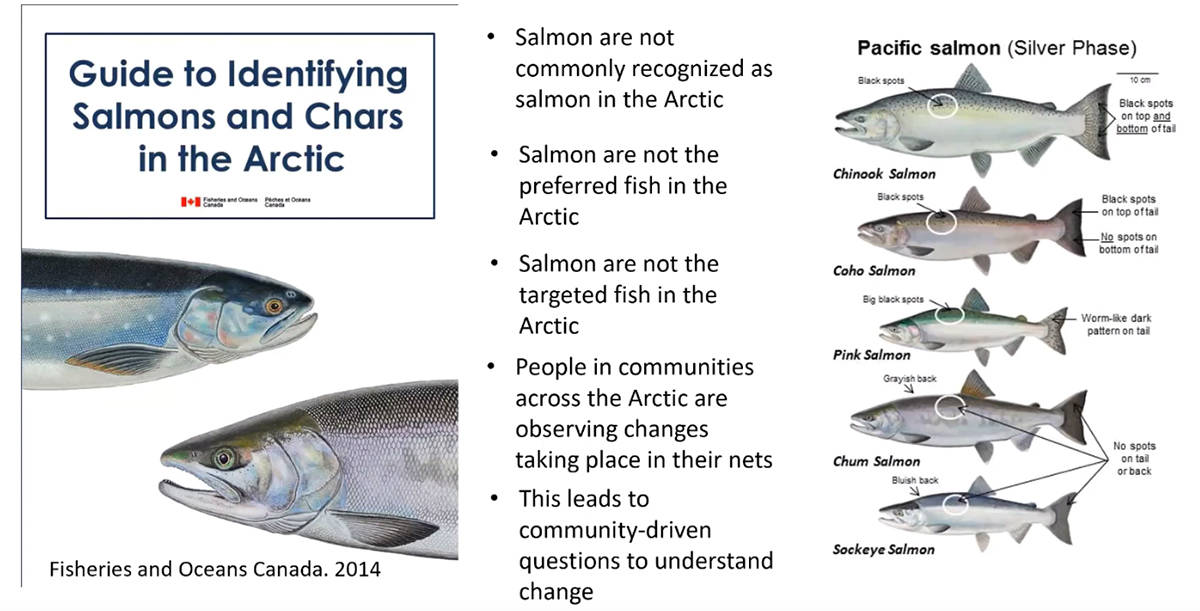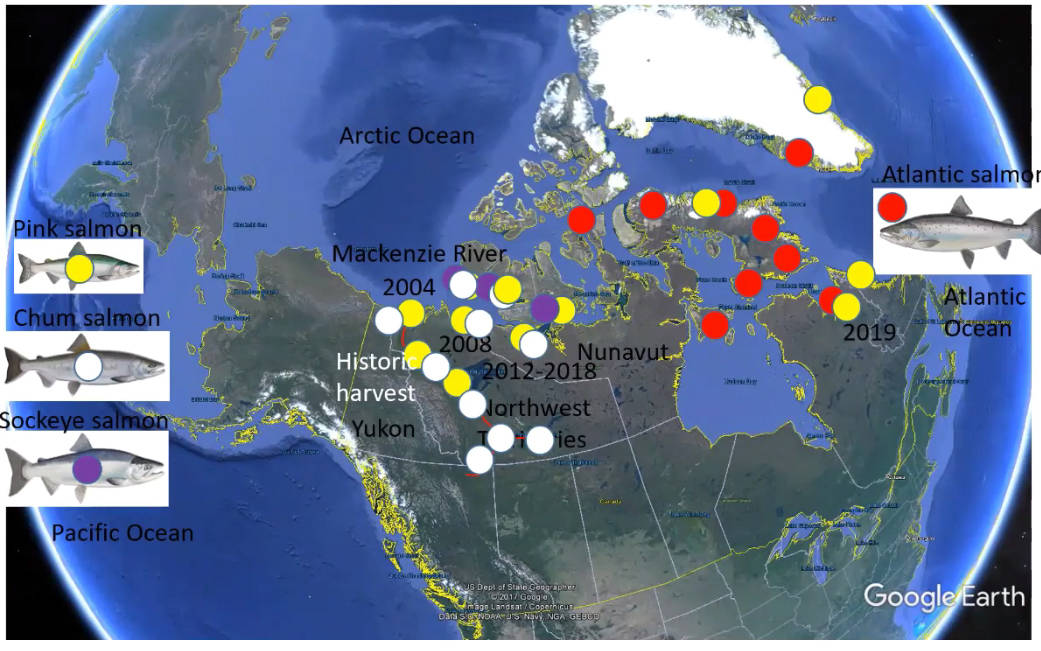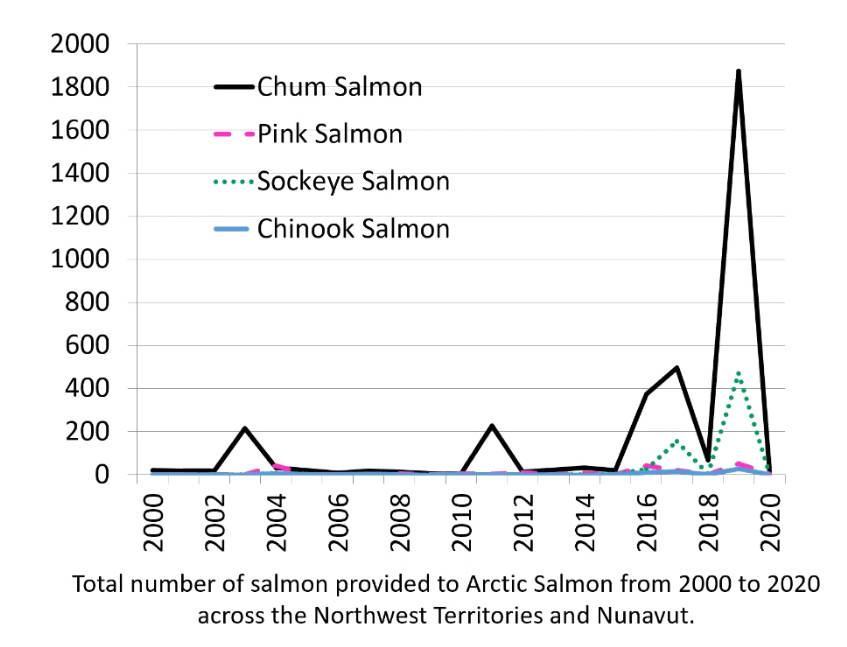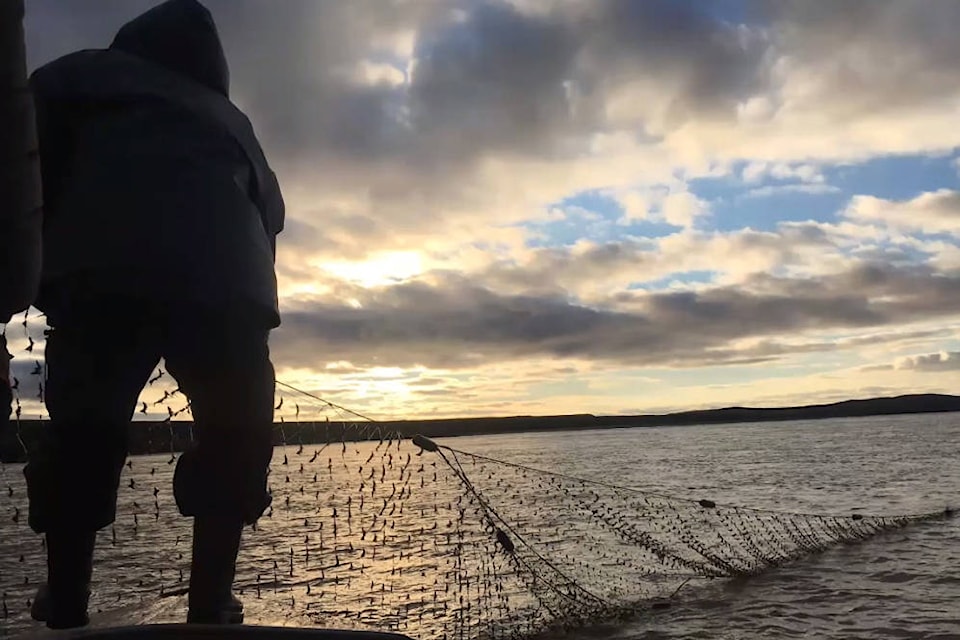Jody Illasiak can remember the first time he saw a salmon.
SA����Ӱ�Ӵ�ý�I could remember a little ways back, probably 20 some odd years ago,SA����Ӱ�Ӵ�ý� he said, recalling a fishing trip up the Hornaday River near Paulatuk. SA����Ӱ�Ӵ�ý�(We) had a net there, so we check it and he pulled out a salmon. I asked him what kind of fish is that because it was the first time ISA����Ӱ�Ӵ�ý�ve ever seen a salmon.
SA����Ӱ�Ӵ�ý�I was pretty young, maybe eight or nine years old. Not too much came out of that one at the time because it was one salmon out of 2,000 char out of the river. Then the (year) 2000s and thatSA����Ӱ�Ӵ�ý�s when we start catching (salmon) along the coast. We had guys almost in every deep fishing hole in our Hornaday river pulling salmon out of their nets.SA����Ӱ�Ӵ�ý�
Why are the salmon here?
The latest installment of the Aurora Research Institute speakers series took place May 20. It featured Illasiak discussing the ups and downs of salmon in the Arctic. Representing the Paulatuk Hunters and Trappers committee, he recounted how the community came to see the invasive species as a problem.
SA����Ӱ�Ӵ�ý�WeSA����Ӱ�Ӵ�ý�re getting no whitefish in our net and then here you got three char with 15 salmon,SA����Ӱ�Ӵ�ý� he said. SA����Ӱ�Ӵ�ý�That was what some of the guys were catching right outside the town here.SA����Ӱ�Ӵ�ý�

Illasiak was SA����Ӱ�Ӵ�ý�pretty comfortable sayingSA����Ӱ�Ӵ�ý� anglers in four communities in the region arenSA����Ӱ�Ӵ�ý�t catching char anymore. Elsewhere, fishers are being forced to find new spots as salmon squeeze out the whitefish.
The pink-fleshed mainstay of British Columbia are swimming farther and farther North as waters warm and sea ice recedes.
To better understand the change, researchers are joining forces with harvesters to get a picture of how the river and oceanic ecosystems are shifting along with the climate.
Researchers noted mapping the spread of salmon in the Arctic takes a lot of eyes, so the Arctic Salmon Project collects data from subsistence catches of fish across the North. In many cases, harvesters turn in the unusual catches, which have included a Salmon Shark SA����Ӱ�Ӵ�ý� which looks like a miniature Great White Shark, in Kugluktuk.
SA����Ӱ�Ӵ�ý�This is a big project,SA����Ӱ�Ӵ�ý� said Department of Fisheries and Oceans Canada (DFO) biologist Karen Dunmall. SA����Ӱ�Ӵ�ý�ItSA����Ӱ�Ӵ�ý�s a collaboration among harvesters, community members, the entire Arctic Salmon Network and scientists from across Canada.SA����Ӱ�Ӵ�ý�

Noting that at this point salmon can be found just about anywhere in the Arctic, Dunmall mapped out where specific species have been found. The data shows the fish are making their way northward, which many species now routinely harvested in Ulukhaktok, Sachs Harbour and beyond.
Salmon that is sent in for research finds its way to Ryan McLeod at the Aurora Research Institute. He and his students take a series of samples and readings, such as the size of the head and the weight of the internal organs.
How many salmon are being caught in the Arctic? It varies from year to year SA����Ӱ�Ӵ�ý� a lot.

A record harvest of 2,400 salmon was recorded in 2019, but only 10 salmon from 2020 have been received for analysis. To make some sense of the variability, DFO biologist Darcy McNicholl said scientists were relying heavily on traditional knowledge of the fish in the area, as some parts of the Arctic have had some historical experience with salmon runs.
Much of that knowledge is coming from the research of environmental graduate student Zander Chila from the University of Victoria. Chila conducted 54 interviews throughout the Inuvialuit Settlement Region (ISR) and said outside Aklavik, where according to traditional knowledge theySA����Ӱ�Ӵ�ý�ve been pulling salmon out of the water forever, the outsider appeared in the Beaufort Delta in the 1990s.
ItSA����Ӱ�Ӵ�ý�s a concern that piles on challenges already faced by fishers, like increased turbidity and erosion.
TheySA����Ӱ�Ӵ�ý�re SA����Ӱ�Ӵ�ý�pretty worried that salmon are coming in bigger numbers, because salmon are going to have potentially unknown effects on local fish,SA����Ӱ�Ӵ�ý� Chila said. SA����Ӱ�Ӵ�ý�We really donSA����Ӱ�Ӵ�ý�t understand what salmon are going to do in the system.SA����Ӱ�Ӵ�ý�
Concerns about salmon include whether the salmon are bringing in harmful amounts of mercury or diseases, are they breeding and if theySA����Ӱ�Ӵ�ý�re competing for food with char. McNicholl said data collected on the last question suggests the salmon are eating different food from char, particularly more invertebrates while char are eating small fish during the time both species are in the same area.
She noted itSA����Ӱ�Ӵ�ý�s unlikely for salmon and char to be competing for the same prey, at least when theySA����Ӱ�Ӵ�ý�re in the ocean-phase of their life cycle.
SA����Ӱ�Ӵ�ý�We donSA����Ӱ�Ӵ�ý�t know what happens when theySA����Ӱ�Ӵ�ý�re in fresh water,SA����Ӱ�Ӵ�ý� said McNicholl. SA����Ӱ�Ӵ�ý�WeSA����Ӱ�Ӵ�ý�re beginning some analyses to look at what happens when the chum when the salmon and char are in fresh water and if they could be eating the same thing, but for our first set of analyses that weSA����Ӱ�Ӵ�ý�ve done so far at least in the ocean side, the char and the salmon seem to be eating different things.SA����Ӱ�Ӵ�ý�
A second major concern of salmon moving in is if they are able to spawn and if so, would they displace Arctic char, which are already under threat from climate change, from their breeding ground. Dunmall noted salmon tend to arrive in the Arctic river systems in the fall and would need to find bodies of water that donSA����Ӱ�Ӵ�ý�t freeze over the winter. Typically this means they would gravitate to groundwater springs.
SA����Ӱ�Ӵ�ý�The fish that are in the Arctic already know where these places are,SA����Ӱ�Ӵ�ý� she said. SA����Ӱ�Ӵ�ý�This is where those fish over-winter. So weSA����Ӱ�Ӵ�ý�re curious is some of these places are suitable for salmon spawning.SA����Ӱ�Ӵ�ý�

So far, research shows the threshold is 4C as the coldest the water can get before salmon lose the ability to spawn. Dunmall said numerous springs along the Arctic fall within that range, so if salmon were able to reach the pools they would be able to lay eggs. Temperature loggers across the Arctic circle monitor the water to determine if a stream is salmon-friendly.
Salmon caught in the Arctic have had eggs, but so far no juvenile fish have been caught or observed. Monitoring young salmon is difficult, noted Dunmall, because the young salmon leave the rivers alongside the spring melt.
So far, scientists have identified six species of salmon now found in the Arctic. Fisheries and Oceans Arctic salmon technician Kevin Gully described the differences between the six, ranging from the larger pacific salmon to the sockeye salmon, which is actually a mispronunciation of the Halkomelem word sθə́qəy̓ (suk-kegh), meaning SA����Ӱ�Ӵ�ý�red fishSA����Ӱ�Ӵ�ý� for the intense red colouring of the fish during spawning.
SA����Ӱ�Ӵ�ý�Inuvialuit and ISR prefer their traditional harvest of char or trout so when salmon are caught people typically do not have a plan for them,SA����Ӱ�Ӵ�ý� he said. SA����Ӱ�Ӵ�ý�Regardless salmon are being harvested more and more and this leads to community driven research questions to understand these changes.SA����Ӱ�Ӵ�ý�
The salmon have an effect on land, too. Illasiak noted during the salmon spike of 2019 the community saw a dramatic change in the behaviour of grizzly bears. In historical salmon spawning grounds, grizzly bears are known for congregating at spawning pools and gorging on the fish as they make their way up-river.
SA����Ӱ�Ӵ�ý�Normally weSA����Ӱ�Ӵ�ý�d have 12 to 15 grizzly bears at our dump park community dump here in town, 12 to 15 bears on average in a day,SA����Ӱ�Ӵ�ý� he said. SA����Ӱ�Ӵ�ý�We had next to no bears in the dump, nothing.
SA����Ӱ�Ӵ�ý�I told my dad those grizzlies must have found a spot for salmon because right then and there was when people started reporting 50, 60, 70-plus salmon, in creeks 30 kilometres inland.
SA����Ӱ�Ӵ�ý�Imagine where they can get, if they can get to the lakes 30 km in.SA����Ӱ�Ӵ�ý�
SA����Ӱ�Ӵ�ý�Some Elders say SA����Ӱ�Ӵ�ý�you know they canSA����Ӱ�Ӵ�ý�t pass this area,SA����Ӱ�Ӵ�ý� they say SA����Ӱ�Ӵ�ý�they gotta walk on land to passSA����Ӱ�Ӵ�ý� and here they are bypassing that stuff.SA����Ӱ�Ӵ�ý�
Watch the presentation:



